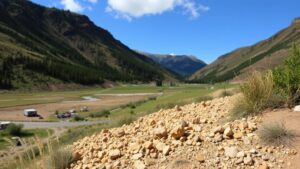Identifying False Bedrock and Its Role in Trapping Gold Nuggets
Identifying False Bedrock and Its Role in Trapping Gold Nuggets
The search for gold nuggets has captivated prospectors for centuries, leading to various techniques and strategies in alluvial gold mining. A crucial element that affects the success of these endeavors is the understanding of geological formations, particularly distinguishing between true bedrock and false bedrock. This article delves into the characteristics of false bedrock, its formation, and its significant role in trapping gold nuggets in sedimentary environments.
Understanding Bedrock and False Bedrock
Bedrock is the solid rock that lies beneath the soil and loose material on the Earths surface. In the context of gold prospecting, true bedrock refers to mineralized formations where precious metals can be found. In contrast, false bedrock is deceptive rock formations that can mislead miners into believing they are approaching true bedrock.
False bedrock typically consists of compacted sediments, hardpan, or indurated soil. These formations may feel solid underfoot, but they do not provide the same value as true bedrock. Recognizing the difference is critical in preventing wasted effort and resources during gold hunting expeditions.
Characteristics of False Bedrock
Identifying false bedrock involves an awareness of several key characteristics that distinguish it from true bedrock:
- Texture and Composition: False bedrock often feels denser than loose soil but lacks the crystalline structure typical of true bedrock, which is composed primarily of minerals like quartz and feldspar.
- Appearance: It may present as a hard layer of clay or compacted gravels, often exhibiting a slick, smooth surface.
- Hydrology: Water will typically not percolate through false bedrock as effectively as through true bedrock, which can often allow moisture and mineral solutions to flow.
Role of False Bedrock in Gold Nugget Trapping
Despite its misleading nature, false bedrock plays a significant role in the deposition and retention of gold nuggets. Here’s how it contributes to trapping gold:
- Physical Barriers: False bedrock creates barriers that can disrupt the flow of water, prompting gold particles to settle as the water slows down. This phenomenon is similar to how a dam alters river flow.
- Natural Traps: Areas of false bedrock may form natural basins where gold can accumulate over time, increasing the likelihood of finding nuggets in these low spots.
Real-World Applications and Case Studies
Understanding the dynamics of false bedrock can significantly influence gold prospecting strategies. For example, during the California Gold Rush, many miners found success in riverbeds where false bedrock was present. These areas often contained rich deposits of gold due to the accumulation effects previously discussed.
Plus, contemporary prospectors utilize geological mapping and sediment sampling to assess areas for potential false bedrock conditions. For example, prospectors using metal detectors will often dig down only to discover false bedrock, yet they may find minute gold flecks in the surrounding sediments, indicating nearby gold sources.
Actionable Takeaways
For aspiring gold prospectors, a nuanced understanding of false bedrock can enhance their chances of finding gold nuggets. Here are a few actionable steps to consider:
- Conduct thorough geological studies of potential sites to identify areas where false bedrock is likely to trap gold.
- Employ tools such as metal detectors or simple hand tools to probe the ground and differentiate layers, looking for signs of true bedrock beneath false formations.
- Use techniques like panning and sluicing in identified areas of false bedrock to maximize gold recovery without overlooking hidden deposits.
By incorporating the knowledge of false bedrock and its implications for gold deposition, prospectors can refine their strategies and improve their discovery rates, maximizing both enjoyment and profitability in their gold-hunting endeavors.



